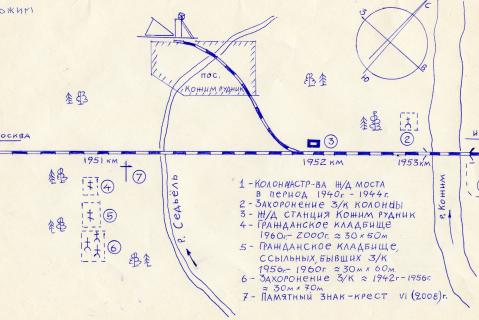The Sevpechlag camp cemetery of the Kozhym mine (transferred in 1944 to Intastroi and in 1946 to the Intaugol combine) was created in the early 1940s. After 1956 local inhabitants, particularly former prisoners and deportees, were buried there. Since 1960 it has become the local graveyard. The numbers of prisoners buried there have not been established; name lists are not available.
The graves and grave-markers of former prisoners and deportees (1956-1960) are well preserved. In 2004 the graveyard by investigated by a joint Lithuanian-Inta Memorial group. Two years later members of the Lithuanian Council of Youth Organisations (“Exploration of places of exile and death”) attached a metal plaque to a birch tree bearing the text (in Russian and Lithuanian) “Here lie deported Lithuanians / A†A Čia ilsisi lietuviai tremtiniai, Lietuvos jaunimo organizacijų taryba “Ekspedicijos i, trėmimo ir žūties vietas” (2006).
On 27 June 2008, thanks to the efforts of the Inta museum of history and local studies and the Memorial Society a wooden commemorative cross bearing the plaque “To the victims of the Gulag” was erected here.
(The map of the area shows the location of: [1] the bridge construction brigade, 1940-1944; [2] the burial ground of the imprisoned bridge builders; [3] the rail station; [4] the civilian graveyard, 1960s to 2000; [5] the civilian graveyard, 1956-1960; [6] prisoners burial ground, 1942-1956; and [7] the 2008 commemorative cross; in relation to the railroad and the Sedyol and Kozhim rivers. Drawn by N.A. Baranov in 2008.)
Repentance: the Komi Republic Martyrology of the Victims of Mass Political Repression (11 vols. 1998-2016), includes biographical entries on 52,785 who were sent to the camps in Komi, of whom over 10,000 died there.
The Memorial online database (2025) lists 129,473 victims in the Komi Republic. (See Nizhny Chov.) Among them were over 64,000 deportees sent to or born in the Republic.
Drawing on various sources the database lists 225 prisoners who were held in Sevpechlag of whom eight are recorded as dying in captivity. (And see The Gulag in Northwest Russia, 1931-1960.)
| Date | Nature of ceremonies | Organiser or responsible person | Participants | Frequency |
|---|---|---|---|---|
|
nk
|
Commemorative Services
|
nk
|
nk
|
From time to time
|
| State of burials | Area | Boundaries |
|---|---|---|
|
no surviving grave posts on camp burials; many areas of subsidence over the burials. Graves and grave-markers have in part survived among the deportees
|
not determined
|
not delineated
|
[ Original texts & hyperlinks ]
Archive of the Inta local history museum
Reply from the Komi Republic Ministry of Culture (No 06-17-1230 of 30 April 2014) to a formal enquiry by RIC Memorial (St Petersburg)

